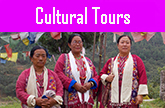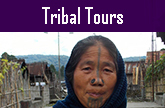Tawang Tour
Tour Duration : 5 Nights / 6 Days
Travel Season : September to June
tawang tour itinerary:
Day 01: Guwahati - Tezpur (166 kms, 4 hrs drive)
Meet upon arrival at Guwahati Airport / Railway Station.
Guwahati:
Guwahati, 'the city of Eastern light' stands on the southern bank of the mighty river Brahmaputra. It is the capital city of Assam and the gateway to the entire north-eastern states. Modern Guwahati is the hub city of Assam. It fulfills every aspect of a metropolitan city with its advanced means of transport, communication and media, as a major center of business activity, educational institutions, and various administrative and political activities of entire Assam. Besides, its landscape surrounded by hills and the mighty Brahmaputra River, rich and diverse flora and fauna enhances its natural scenic beauty.
If time permits, visit in Guwahati -
Kamakhya Temple:
Kamakhya Temple, one of the greatest 'Shaktipeeth', the shakti shrine of Goddess Kamakhya is situated on the Nilachal Hills. It is the oldest center of Tantric Shaktism. A famous legend regarding the birth of the Kamakhya temple narrates that Lord Shiva, rage with anger at his wife Sati's death, wandered the entire earth carrying Sati's corpse. An organ of Sati fell here and eventually the place became a temple of worship in due course of time. The temple features various stone inscriptions, terracotta works, sculptures and idols of Ganesha and Chamundeswari which are worth mentioning. The famous 'Ambubachi Fair' is celebrated with great enthusiasm every year in mid-June in this temple and devotees from different parts of India throng into it for the special occasion.
Srimanta Sankardev Kalakshetra:
Sankardev Kalakshetra is named after the most illustrious son and Vaishnavite propagator of Assam. It is the hub of all the cultural activities of entire Assam and a center for the promotion and preservation of the cultural heritage of the various tribes, communities and ethnic groups of Assam. It consists of a museum wherein lies the various traditional dresses, jewelry, ancient pottery, weapons belonging to various ethnic groups, sculpture, and works of art created by various artists depicting as a whole the entire Assam. The open air amphitheatre, wherein the cultural performances are held very often and the collection of whole life activities of the legendary artist Dr. Bhupen Hazarika carry a great measure in Kalakshetra.
Later, take transfer to Tezpur.
Tezpur:
Tezpur, the 'city of love' is situated on the northern bank of the Brahmaputra River. The ancient name of Tezpur was Sonitpur, the kingdom of the mighty legendary king, Baan Raja. It was the capital city under his reign. Tezpur holds in its heart many ancient historical events, and witnessed many legends and mythological wars of ancient Assam. The occurrence of a famous war named 'Hari-Hara' is related with the attainment of the present day Tezpur. This battle led to the bloodshed of so many soldiers that the entire place was stained with blood and hence the city came to be known as Tezpur ('Tez' meaning blood and 'pur' meaning city in Assamese language). Present day Tezpur was founded by the British colonial administration in 1835 as the headquarters of Darrang district.
Arrive at Tezpur, check-in hotel. Later, visit at Tezpur -
Agnigarh:
Legend speaks of Agnigarh as a fortress built by Baan Raja in order to keep his daughter in isolation. The word 'Agnigarh' is a derivation of two Sanskrit words: 'Agni' meaning 'fire' and 'garh' meaning 'fort'. Situated on the north bank of the Brahmaputra River, it maintains its gracefulness with its lush green landscapes of the river. Nowadays, magnificent works of sculpture are depicted referring to the love story of Usha-Aniruddha and Great War 'Hari-Hara Juddha'.
Mahavoirab Temple:
Mahavoirab temple is the oldest Shiva shrine, where the second biggest Shiva linga of the world is worshipped. The temple was built by King Baan, the ruler of Sonitpur in 10th century. King Baan's daughter Princess Usha was a devotee of Lord Shiva and visited the temple for daily worship. Thousands of devotees gather during Shivaratri every year to offer prayers in this temple.
Evening: Free at leisure. Overnight: Stay in hotel.
Day 02: Tezpur - Dirang (202 kms, 6 & 1/2 hrs drive)
In the morning after breakfast, take transfer to Dirang. En-route visit -
Bhalukpong:
Situated on the Assam-Arunachal border, Bhalukpong is widely acclaimed to be a popular tourist spot with the Kameng River flowing through it. It is a famous location for picnic lovers and adventurous tourists.
Tipi Orchid Sanctuary:
Also known as Tipi Orchidarium, this sanctuary is a home to a large collection of about 234 varieties of colorful orchids. Some rare and endangered species of orchids are displayed in the glass house. Some of these orchids have a quality of blooming for a longer duration. This sanctuary serves as an orchid research and development centre set up by the Department of Environment and Forest under Govt. of Arunachal Pradesh for the conservation and development of new variety of species.
Naag Temple:
Naag Temple is one among many Naag (Snake) temples in the region that worships snakes. One can get a majestic view of the Kameng River along with the lofty hills and picturesque valley from the temple atop.
Tenga valley:
Tenga valley is a small town situated in a valley of the Eastern Himalayas in Arunachal Pradesh. It is an important landmark for those traveling to Tawang in the Western end of Arunachal Pradesh. This small town, which also doubles up as an important army check post is blessed with some splendid Himalayan vistas. Tenga valley is situated at an altitude of 6,500 feet above sea level.
After crossing Bomdila, en-route - have a glimpse of Gorichen and Kangto peak.
Later, depart to Dirang.
Dirang:
A sub-divisional head quarter of West Kameng district, Dirang is situated at an altitude of 4910 feet above sea level. It is the habitat of the Tribal Mahayana Monpas. The mild and soothing weather of Dirang with a pleasant wind blowing across the valley endows Dirang as a perfect hill station. Moreover, it also serves as a site for adventure sports like trekking, nature walk, bird watching, sightseeing etc.
Arrive at Dirang. Visit -
Sangti Valley:
Surrounded by the towering ranges of Eastern Himalayas, blessed with pleasant weather round the year with maybe some light snowfall in the winter months, covered with fruit orchards (kiwi fruit, apple, apricot, orange), dotted with pristine forests and meandering fast hill rivers and home to a very interesting culture and tradition. Sangti Valley is surrounded by Eastern Himalayan ranges and you will find this area rich in dense forests and rivers. Black-necked cranes migrate to this valley from China during the months of November and December and after the winter months are over, they set back to their homes during April and May. These birds are referred to as tung tung ka uk by the people of Sangti Valley.
Thereafter, check-in hotel. Overnight: Stay in hotel.
Day 03: Dirang - Tawang (138 kms, 5 hrs drive)
In the morning after breakfast, visit at Dirang -
Kalachakra Monastery:
Kalachakra Monastery is a 500 years old Buddhist Gompa. It belongs to the Gelugpa school of Tibetan Buddhism.
Hot Water Spring:
Hot water spring is a famous picnic spot which beckons tourists as well as the local people. These hot springs are designated to possess some special healing properties, which makes it a main centre of attraction even to the locals. They mainly visit these springs for holy baths, as it is locally believed that a dip in these springs cleanses all sins and skin diseases.
Later, depart to Tawang. En-route visit -
Jaswant Garh:
The resting abode of the valorous son of the soil, Jaswant Garh is the memorial place built in honor of Mahaveer Chakra awardee (posthumously), Jaswant Singh Rawat. It speaks of the indisputable spirit of this patriot who fought continuously for 72 hours (along with 2 other soldiers) killing 300 Chinese soldiers during 1962 Indo-China War.
Sela Pass:
The entrance to the Tawang Valley, this narrow pass stands at an altitude of 13,714 feet featuring a landscape of frozen lakes, enchanting tiny flowers of different shades, uneven roads and remains of landslides.
Nuranang Waterfall:
Have a brief look at the spectacular natural beauty of Nuranang waterfall, locally known as Phong Phongma waterfall.
Arrive at Tawang and check-in hotel.
Tawang:
Tawang, the majestic homeland of the Monpas, shares international borders with Tibet and Bhutan standing at an altitude of about 10,000 feet above sea-level. It showcases a scenic view of snow-capped mountain ranges, silent and typical tribal villages, uneven hills, enchanting streams and waterfalls and quiet lakes. Tawang is the abode of the Mahayana Buddhist sect replete with magnificent Buddhist monasteries. Moreover, it is also an adventure's delight as it offers ample scope for exciting trekking and mountaineering experiences.
Evening: Free at leisure. Overnight: Stay in hotel.
Day 04: Tawang
In the morning after breakfast, take a full day excursion of Tawang visiting -
Tawang Monastery:
Tawang is home place of the second largest monastery in the world. The Tawang Monastery is set amidst snow-capped mountains and beautiful valleys. It houses about 450 monks, their residential buildings, library, meeting hall, community kitchen and a three storied prayer hall called Dukhang. Established during 1680-1681 by Merak Lama Lodre Gyatso after fulfilling the wishes of the 5th Dalai Lama, Ngawang Lobsang Gyatso, Tawang monastery is renowned to be the prominent centre of the Gelugpa sect, the socio-religious hub of Tawang for the last 400 years and also a base for Buddhist cultural studies. This magnificent monastery is a visitor's attraction for its beautifully carved 8 meter high, gold plated Bronze idol of Lord Buddha. It treasures a large number of images, Thangkas, mural paintings, and sacred Buddhist ancient scriptures lettered in Gold.
Urgelling Monastery:
The birthplace of His Holiness, the 6th Dalai Lama Urgelling Monastery was established by the Lama Urgen Sangpo. This monastery houses many ancient Buddhist relics along with the footprints and fingerprints of the Dalai Lama, kept for visitors to seek blessings.
Giant Buddha Statue:
Make a visit to the giant Buddha statue located near the Circuit House facing towards the Tawang city. The majestic statue is visible from all parts of the town. It is a serene place to relax and pray.
Craft Centre:
Tawang is rich in unique crafts and handloom products. Variety of craftsmanship is displayed in carpet weaving (woolen carpets), wood carving, handmade papermaking, Thangka painting showcasing a Buddhist influence and sandalwood making.
Local Market:
Make a visit to the local market at Tawang for shopping.
In the evening, visit -
Tawang War Memorial:
A 40 feet multi-colored war memorial built in honor of the martyrs who sacrificed their lives during 1962 Indo-China War. Locally called 'Namgyal Chorten', the memorial is constructed in a stupa design. It bears the names of 2420 warriors written in Gold on 32 black granite plaques.
Optional sightseeing -
Bumla Pass:
Situated at an altitude of 16,500 feet. Bumla Pass displays the monuments of the brave soldiers who sacrificed their lives for the sake of the nation during 1962 Indo-China War. At present, the pass is a military border post for both Indian and Chinese army.
Sangetsar Lake:
Tawang is acclaimed as a nature's delight for its shinning silver lakes, the most popular one being the Sangetsar Lake, surrounded by trees. Also known as Madhuri Lake, the lake was formed during the disastrous earthquake that occurred in 1950 A.D and featured in Shahrukh Khan and Madhuri Dixit starrer Bollywood Hindi thriller movie 'Koyla'.
P T Tso Lake:
The magnificent Pangkang Teng Tso Lake looks like a painter's masterpiece. The shimmering silver lake appears like a blue lapis 'Lzuli' on a bright, clear day encompassed by flowers of different hue during October. The winter months cover the lake with snow changing its colour to stark white.
Ani Gompa (The Nunneries):
The Nunneries are women monasteries, where the nuns adopt priesthood willingly without any compulsion. The oldest of Ani Gompa is Brahma-dung-chung Ani Gompa, commissioned by Lama Karchan Yeshi Gelek in 1595 A.D. Gyangong Ani Gompa, Singur Ani Gompa, Gorsen Chorten are some of the prominent woman monasteries.
Overnight: Stay in hotel.
Day 05: Tawang - Bomdila (180 kms, 6 hrs drive)
In the morning after breakfast, take transfer to Bomdila. En-route visit -
Lhou Village:
Lhou village is an ancient Monpa village. The origin of the village dates back to 16th century or earlier. Buddhist legend speaks of the Monpa tribe as migrants of the plains to Tawang while the Monpa tradition narrates them to be the migrants from Sikkim and Phari. The base of their economy is agriculture, mainly terrace cultivation. Breeding of Yak and mountain sheep is also practiced by some people.
Rock Paintings:
The rock paintings located near Jung includes rock carvings of Lord Buddha Shakyamuni, Avalokesteshuara and Guru Padmasambhava. This spot dedicated in the name of world peace and well being of all people by the former Chief Minister of Arunachal Pradesh, Late Dorjee Khandu, reflects his selfless love for his subjects and ardent devotion to Buddhism.
Later depart to Bomdila. En-route visit near Dirang -
Dirang Village (Basti):
Dirang village, locally known as Dirang Basti is a beautiful village inhabited by Monpa tribal people. The Monpas are the tribal inhabitants residing in Tawang and West Kameng districts of Arunachal Pradesh. The Monpas are the supporters of the lamaistic tradition of Mahayana Buddhism. The presence of beautifully decorated Buddhist Gompas in the village reflects their religious enthusiasm.
Dirang Dzong:
Dirang Dzong Fort is a representation of the culture of the Monpas. This fort, built in 1831 A.D. served as a centre of all the administrative activities of the Monpas during those times. The fort is set atop on a hill top consisting of a four storied stone building. A wooden gate designed in local architectural pattern adds to the splendid uniqueness of the fort.
Arrive at Bomdila. Check-in hotel.
Bomdila:
Snow-covered mountains, marvelous countryside, lush green forests, Apple orchards and Buddhist Gompas endows Bomdila, located at an altitude of about 8,000 feet above sea level. It is the land of the Monpa, the Sherdukpen, the Aka, the Miji and the Khawa tribes. It is a perfect place for trekking and hiking trails and a centre of local crafts and handloom products. Bomdila offers a magnificent view of Kangto and Gorichen peaks (the highest peaks in Arunachal Pradesh) amidst the Himalayan landscape and snow-capped ranges.
Evening: Free at leisure. Overnight: Stay in hotel.
Day 06: Bomdila - Kalaktang - Guwahati (282 kms, 8 hrs drive)
In the morning after breakfast, visit at Bomdila -
Bomdila Monastery:
Bomdila Monastery is designated to be the proud possessor of the largest and newest monastery called 'The Gelugpa Gompa'. A reflection of Buddhist and Tibetan heritage and culture, the monastery was established during 1965-66, by the 12th reincarnate of Tsona Gontse Rimpoche. The monastery stands as a comparison to Tsona Gontse Monastery at Tsona in South Tibet started during 15th Century. Present renovation added to this Gompa is the main prayer hall, which was dedicated to the service of God by his Holiness, the 14th Dalai Lama on 13th October, 1997 AD.
Craft Center:
Make a visit to the Craft Center where very fine wooden carpets of colorful designs and Masks are produced.
Later, take transfer to Guwahati Airport / Railway Station to catch flight / train for your onward destination.
Tour terminates here
North East India Tourism
Package Inclusions:
# All ground transportation by a dedicated and exclusive vehicle driven by our experienced and friendly driver
Package Exclusions:
# Any air fare or train fare


















